Thanks a lot, well we will see ;D depents partly on the Japanese too (if Vietnam does not behave their enemies all around might be aided by the Japanese)...
You are using an out of date browser. It may not display this or other websites correctly.
You should upgrade or use an alternative browser.
You should upgrade or use an alternative browser.
The Co-Prosperity Sphere
- Thread starter CountofDooku
- Start date
Threadmarks
View all 912 threadmarks
Reader mode
Reader mode
Recent threadmarks
Chapter 884: Hitler's former Cabinet – A tale of Robert Ley Chapter 885: Imperial Mengjiang Army Uniforms, Ranks, Tactics and Strategy of the Imperial Chosen Army Chapter 886: Mengjiang Khanate Navy and SNLF Chapter 887: The Yankoku Prince and Emperor Chapter 888: Mini-Submarine Carrier Submarines Chapter 889: Capture of the D’Entrecasteaux Islands Chapter 890: The Iberian WallDo you have a map of the co prosperity sphere? And can I have a list of all the nations/puppets/provinces in it? Just asking.
Sure here's a map with some provinces:Do you have a map of the co prosperity sphere? And can I have a list of all the nations/puppets/provinces in it? Just asking.
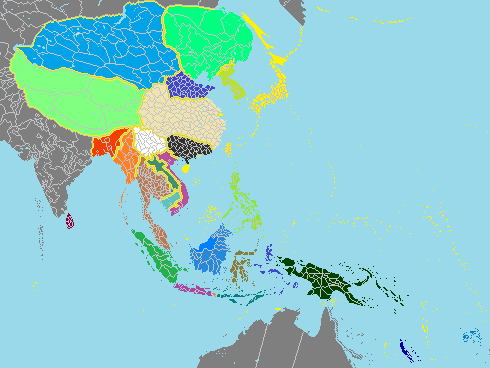
Have to look at all officiall nation/ state names tomorrow. ;D
Chapter 528: Coprospist States: the Bruneian Empire/ Empire of Brunei
Chapter 528: Coprospist States: the Bruneian Empire/ Empire of Brunei:

The Coprospism inside the Bruneian Empire/ Empire of Brunei (also known as Sultanate of Brunei, Negara Brunei, or the Malayan Sultanate) led by Sultan Ahmad Tajuddin had very few political parties and groups, as most of the state was ruled directly by the sultan himself. However the increasing Malayan population coming from the Malayan Paninsula that had been annexed by Siam/ Thailand changed this. Suddenly many partly democratic or federate elements were known by many of his subjects and Sultan Tajuddin implemented spme of this ideas, like a Bruneian Imperial Council, were Sultans, not native chiefs represent their administrated domains together with their male heirs and relatices (Crown Princes and Princes). Officially known as the Sultans Congress, many foreigners refer to it (wrongly so) as the Imperial Bruneian/ Borneo/ Malayan Princess Congress, because the number of Princes (who often have no voice but are mainly observers or advisers of their ruler there) easily outweights that of the Sultans there. The Imperial Bruneian/ Borneo/ Malayan Diet meanwhile was not directly involved in making laws or aiding the Sultan, but it elected a form of parliament of representatives by the Malayan people itself. They mostly governed themselves and were even allowed to appoint/ vote their local leaders, chief and other minor administration positions (who still had to be approved by their Sultans). Inside this Diet, the Brunei/ Malaysian National Party had the interests of the million new incoming Malayans in mind, who would colonise the whole Borneo Island under the Brunai dynasty.
The so called Brunei/ Malaysian People's Party meanwhile hoped to fight for the interests of the farmers, peasents and even the local indiginous chiefs and tribes like the Murut, Kenyah, Kayan, Bahau, Punan, Iban, Ot Danum, Ngaju, Dayak, Maanyan, Lawangan or other groups. Other major ethnic groups included Chinese, who before the Second Great War had dominated the trade in the region. However under Japanese pressure many of this chinese were expelled in favor of the Japanese Zaibatsu (conglomerates) now dominating the trade. They and the Imperial Japanese Army, the Imperial Japanese Navy and Japanese Settlers formed their own political interest group, the Japanese Interest League who also advised and heavily influenced Sultan Tajuddin, who was heavily depending on them for military security, transport by sea and even economical and industrial development. Some of this native populations later converted to Buddhism and Shintoism (in some provinces and regions up to 25-35% of the original population of 3,089,000), but the increasing numbers of 1,894,000 Malayans helped to preseve a Mohammedan characer of the island even if around 100,000 Japanese and Buddhist/ Shinto settlers came alongside 670,000 Chinese, 370,000 Indian from the former Malayan (now Siamese/ Thai) Paninsula. The Sultan therefore heavily relied on the loyality of the increasing Malay population given to him by the Japanese and Siam/ Thailand after the later annexed Malaysia and expelled the Malayan population from the Peninsula. He also relied on the loyal Banjarese population who, together with the Malayans gave the Bruneian Empire/ Empire of Brunei a firm hold of the coastal Island region of Borneo for their expanded Brunai Malayan National State.
Starting from the coastal region further inland new Malay colonial towns and cities were foundet alongside the rivers first, steadily expanding inland and replacing jungle forests with plantations. New streets and railways connected this new settlements with that on the coast and even some local, native tribes and groups further inland. This modernisation and increasing Malay Colonisation changed the face of the island forever and much faster then ever before in such a short period of time. While many natives at first welcomed their new Malayan settlers with open arms, the increasing number of two millions of them coming to settle in their tribal lands soon turned them against this masses, who turned their native hunting and farming lands into their own settlements and plantations. Former friendly welcomes turned into hostilities, even when the partly social Brunei/ Malaysian People's Party tried to advocate for more rights for them. One of the major goals for the Brunei/ Malaysian People's Party and the natives was their own reservations, but the majority of Malayan settlers/ colonists with the support of the Sultan and even the Japanese had the majority and denied any implementation of such idea that would oppose the internal settlement and colonisation of the inner island for the Bruneian Empire/ Empire of Brunei.
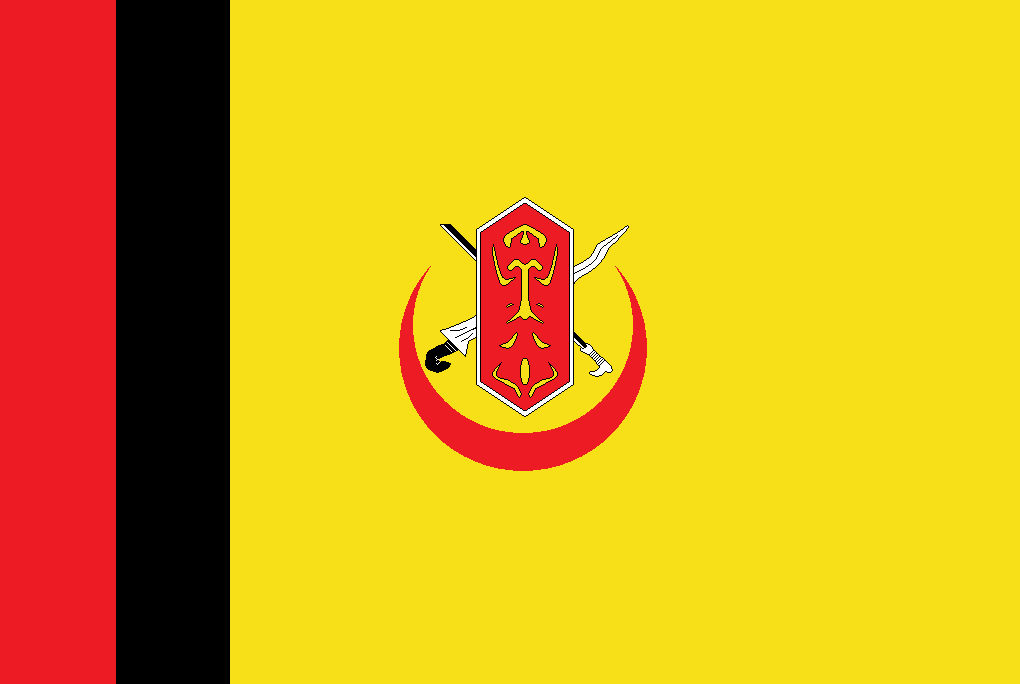

The Coprospism inside the Bruneian Empire/ Empire of Brunei (also known as Sultanate of Brunei, Negara Brunei, or the Malayan Sultanate) led by Sultan Ahmad Tajuddin had very few political parties and groups, as most of the state was ruled directly by the sultan himself. However the increasing Malayan population coming from the Malayan Paninsula that had been annexed by Siam/ Thailand changed this. Suddenly many partly democratic or federate elements were known by many of his subjects and Sultan Tajuddin implemented spme of this ideas, like a Bruneian Imperial Council, were Sultans, not native chiefs represent their administrated domains together with their male heirs and relatices (Crown Princes and Princes). Officially known as the Sultans Congress, many foreigners refer to it (wrongly so) as the Imperial Bruneian/ Borneo/ Malayan Princess Congress, because the number of Princes (who often have no voice but are mainly observers or advisers of their ruler there) easily outweights that of the Sultans there. The Imperial Bruneian/ Borneo/ Malayan Diet meanwhile was not directly involved in making laws or aiding the Sultan, but it elected a form of parliament of representatives by the Malayan people itself. They mostly governed themselves and were even allowed to appoint/ vote their local leaders, chief and other minor administration positions (who still had to be approved by their Sultans). Inside this Diet, the Brunei/ Malaysian National Party had the interests of the million new incoming Malayans in mind, who would colonise the whole Borneo Island under the Brunai dynasty.
The so called Brunei/ Malaysian People's Party meanwhile hoped to fight for the interests of the farmers, peasents and even the local indiginous chiefs and tribes like the Murut, Kenyah, Kayan, Bahau, Punan, Iban, Ot Danum, Ngaju, Dayak, Maanyan, Lawangan or other groups. Other major ethnic groups included Chinese, who before the Second Great War had dominated the trade in the region. However under Japanese pressure many of this chinese were expelled in favor of the Japanese Zaibatsu (conglomerates) now dominating the trade. They and the Imperial Japanese Army, the Imperial Japanese Navy and Japanese Settlers formed their own political interest group, the Japanese Interest League who also advised and heavily influenced Sultan Tajuddin, who was heavily depending on them for military security, transport by sea and even economical and industrial development. Some of this native populations later converted to Buddhism and Shintoism (in some provinces and regions up to 25-35% of the original population of 3,089,000), but the increasing numbers of 1,894,000 Malayans helped to preseve a Mohammedan characer of the island even if around 100,000 Japanese and Buddhist/ Shinto settlers came alongside 670,000 Chinese, 370,000 Indian from the former Malayan (now Siamese/ Thai) Paninsula. The Sultan therefore heavily relied on the loyality of the increasing Malay population given to him by the Japanese and Siam/ Thailand after the later annexed Malaysia and expelled the Malayan population from the Peninsula. He also relied on the loyal Banjarese population who, together with the Malayans gave the Bruneian Empire/ Empire of Brunei a firm hold of the coastal Island region of Borneo for their expanded Brunai Malayan National State.
Starting from the coastal region further inland new Malay colonial towns and cities were foundet alongside the rivers first, steadily expanding inland and replacing jungle forests with plantations. New streets and railways connected this new settlements with that on the coast and even some local, native tribes and groups further inland. This modernisation and increasing Malay Colonisation changed the face of the island forever and much faster then ever before in such a short period of time. While many natives at first welcomed their new Malayan settlers with open arms, the increasing number of two millions of them coming to settle in their tribal lands soon turned them against this masses, who turned their native hunting and farming lands into their own settlements and plantations. Former friendly welcomes turned into hostilities, even when the partly social Brunei/ Malaysian People's Party tried to advocate for more rights for them. One of the major goals for the Brunei/ Malaysian People's Party and the natives was their own reservations, but the majority of Malayan settlers/ colonists with the support of the Sultan and even the Japanese had the majority and denied any implementation of such idea that would oppose the internal settlement and colonisation of the inner island for the Bruneian Empire/ Empire of Brunei.

Last edited:
Thank you.Sure here's a map with some provinces:

Have to look at all officiall nation/ state names tomorrow. ;D
Did Japan decide that Australia was honourable enough to keep alive ITTL? Or are they going to attempt to form a puppet state there?
Dreaming Eagle
Banned
I myself sadly lack the skills to do so but have so many ideas for naitional focus or decisions, i anyone could help me with this modding wise I would gladly accept any help and support to work on it together with you all.
If I wanted to make a separate working thread for this under which section here would it go?
That'll be interesting.
The later but their invasion at Darwin is kind of stalling as they underestimated Australia ....Did Japan decide that Australia was honourable enough to keep alive ITTL? Or are they going to attempt to form a puppet state there?
Will make a threat for that project if you guys can tell me where it would belong in this forum? ;DThat'll be interesting.
Last edited:
And here we go! Everyone interested in helping out there, just watching or suggesting ideas fel free to participate.That'll be interesting.
From what I see New Guinea is free for Japan to colonize. Small number of people that can transport to other place, big enough for ton of Japanese. For me, they're the same with Brunei. Though, Japan is more liberal than otl they should take some thing other than northen Sakhalin after the war, right?
They will use some states as Japanese colonies for settling like Manchukuo and New Guinea, Brunei will at first have 2 million Malayans from the Malayan Peninsula, but afterwards be settled by Japanese too. ;DFrom what I see New Guinea is free for Japan to colonize. Small number of people that can transport to other place, big enough for ton of Japanese. For me, they're the same with Brunei. Though, Japan is more liberal than otl they should take some thing other than northen Sakhalin after the war, right?
As promised the third new flag (this one for Java):
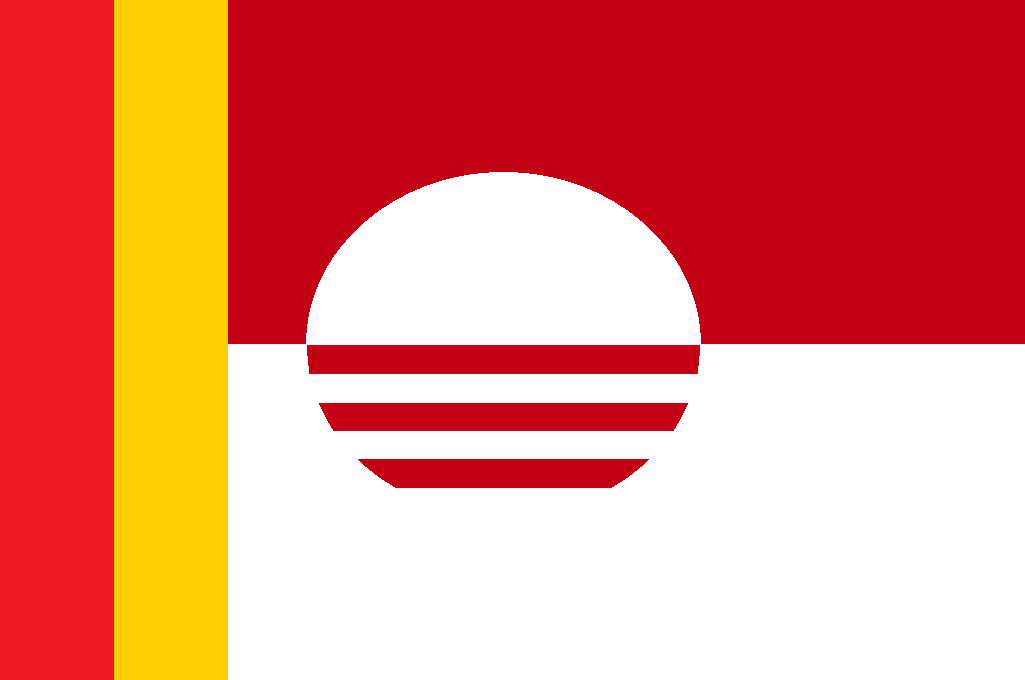
Java flag 1

Java flag 2
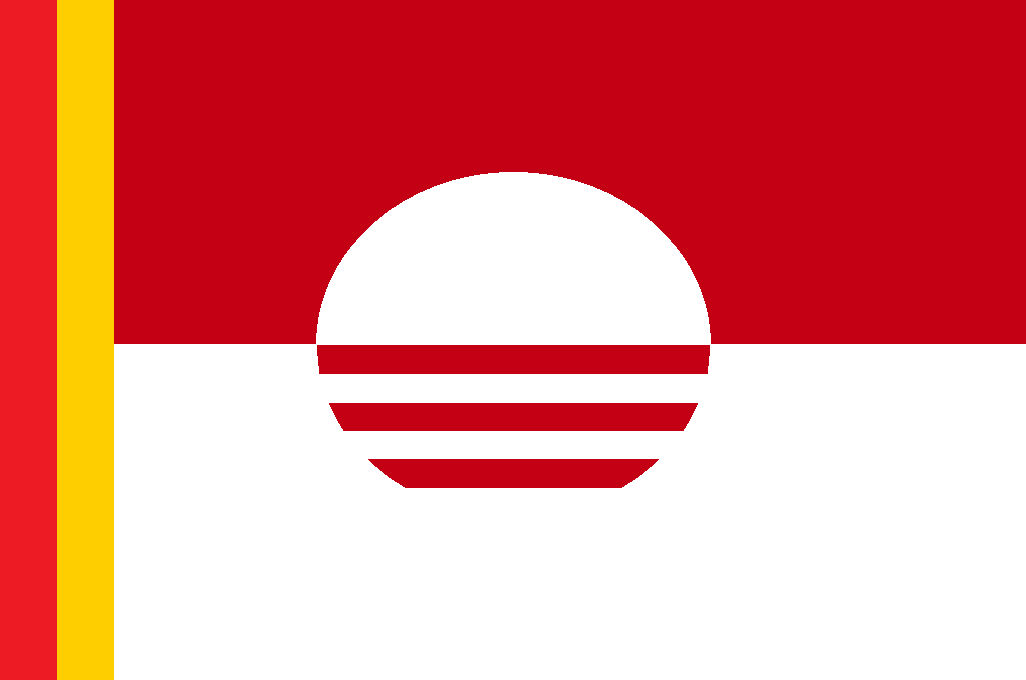
Java flag 3

Java flag 4
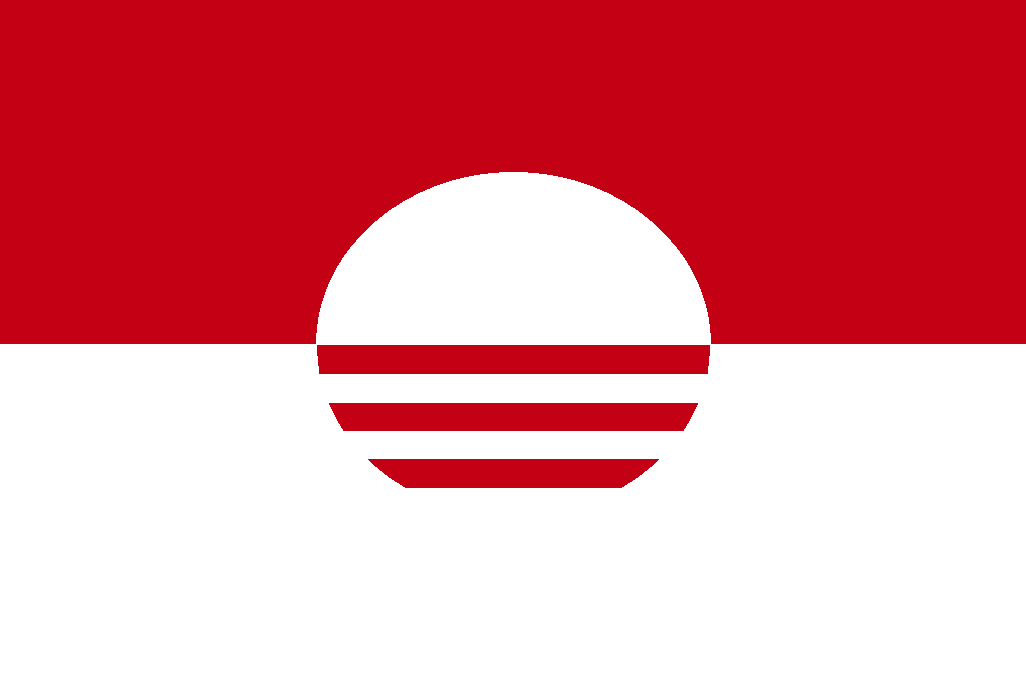
Java flag 5

Java flag 6
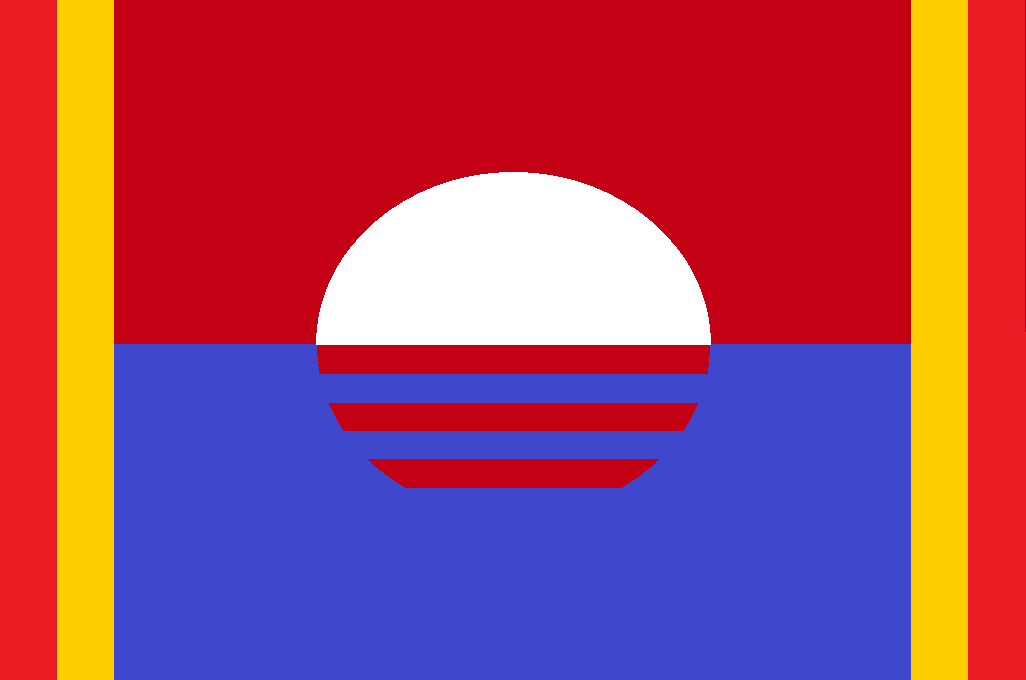
Java flag 7

Java flag 8

Java flag 9
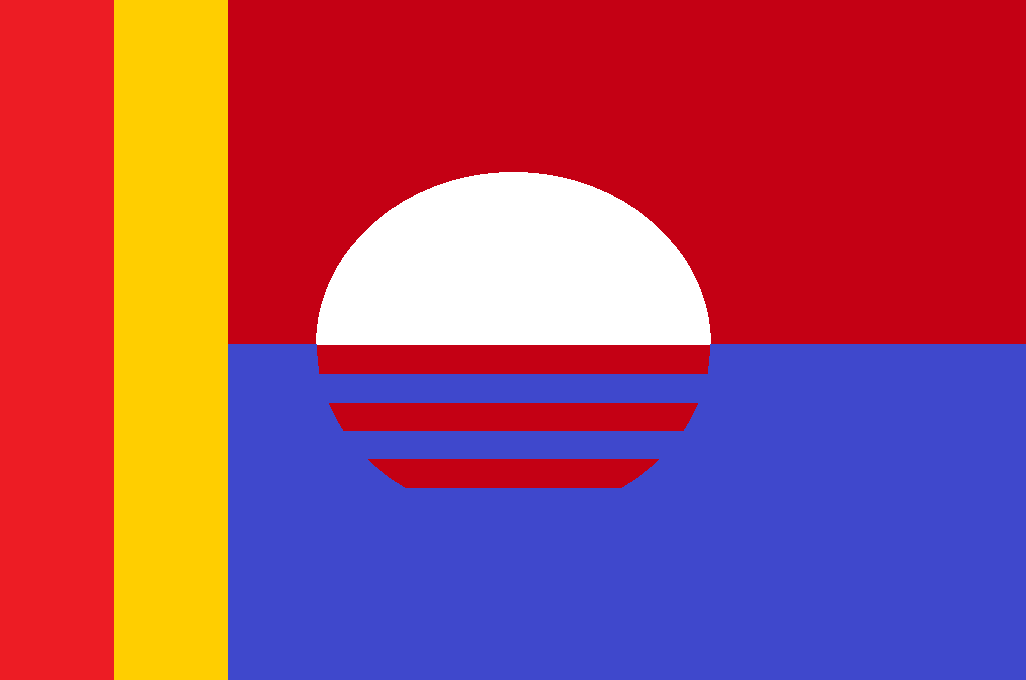
Java flag 10
What version will it be, vote now here!
Vote will be open till Wednesday. ;D
But feel free to purpose other ideas and opinions for this flag as well if you have them.
As for what is on these flags/ their meaning:
Red represents one of Japan's sun sunshines, yellow represents the Hindu-Buddhism past of the island, while the overall sun and it's reflection in the water (white or blue) also represents the Japanese sun, as well as the former flag of the Majapahit Empire. The single waves at the same time represent the administration division and the self-determination and democracy at the lower parts of the Javanese Karaton (Java Empire/ Kingdom). Secretly it's old meaning, inspired by the Majapahit Empire also stands for pan-Indonesian ambitions.

Java flag 1

Java flag 2

Java flag 3

Java flag 4

Java flag 5

Java flag 6

Java flag 7

Java flag 8

Java flag 9

Java flag 10
What version will it be, vote now here!
Vote will be open till Wednesday. ;D
But feel free to purpose other ideas and opinions for this flag as well if you have them.
As for what is on these flags/ their meaning:
Red represents one of Japan's sun sunshines, yellow represents the Hindu-Buddhism past of the island, while the overall sun and it's reflection in the water (white or blue) also represents the Japanese sun, as well as the former flag of the Majapahit Empire. The single waves at the same time represent the administration division and the self-determination and democracy at the lower parts of the Javanese Karaton (Java Empire/ Kingdom). Secretly it's old meaning, inspired by the Majapahit Empire also stands for pan-Indonesian ambitions.
Voted. I think I've figured out what is wrong with IE - the hit-box that you click in order to vote is to the left of the actual tick box graphic... 

Chapter 529: Coprospism: Balinese Soekawatiism
Chapter 529: Coprospism: Balinese Soekawatiism

The Coprospism inside the Kingdom of Bali, (Bali Dwipa) under Tjokorda Gde Raka Soekawati had a special role inside the Co-Prosperity Sphere, even withing South-East Asia. The Balinese shared a Buddhist past with Japan and some of the Japanese honor values as well, as they to knew of Puputan, a ritual suicide, they prefered, before facing the humiliation of surrender, similar to the Japanese Seppuku. While formerly Buddhist dominated and influenced, the new Bali Kingdom was in it's majority Hindi/Hindu by now, even if it also had some Christian and Mohammedan minorities. The government set up under Tjokorda Gde Raka Soekawati by the Japanese, was formed by the Hindu majority and was a a National, Monarchic and Authoritarian Coprospist state based on the Hindu Caste System. This meant that while the Brahmana/ Brahmin (priests, scholars and teachers) were the highest Caste, the true authority of the King and the aristrocracy was in the hands of the Kshatriyas/ Satrias (rulers, warriors and administrators) as the second highest Caste. The Kshatriyas also increased heavily after the Japanese liberation of Bali and Lombock with it's 1,650,000 inhabitants, because the number of administrators and government officials in a new, modern state increased and also because a local militia, army and navy formed to defend the Kingdom of Bali independently as a part of the greater Co-Prosperity Sphere. The main support for the new Bali state was also a tool of Japanese propaganda, as they hoped to form a ideal version of a Mohammedan and Hindu state to gain even more support in India (Hind) and encourage anti-British revolts and rebellions (hopefully alongside their own planned invasion). The third Caste, the Wesia/ Vaishyas (agriculturalists and traders), not only supplied Bali itself with food and plantation prducts, but also tradet their goods with other nearby member states of the Co-Prosperity Sphere like Java, Tenggara/ Timor, Celebes/ Sulawesi, Borneo, Niugini/Niu Gini (New Guinea) and even far away Japan.
The forth Caste, the Soedra/ Shudra (laborers and service providers) worked to keep all of this in the new state running and at low costs. They even helped to build the new harbors and the airfield of Bali and it's capital Gelgel, but also most of everyday life. However inside the Caste hirarchy they had no saying in political matters and not even a vote in public elections, something Subhas Chandra Bose saw as a dangerous modell for Azad Hind, the independent India. The tensions this created inside the Kingdom of Bali were partly eased with the announcement of a diet or parliament for Bali. However the ruling Casts feared that this could give the Shudras the ability to get a vote and saying in their own matters or overall Bali affairs. This meant that the Shudras Caste members had no vote, while the Vaishyas Caste members had a single, regular vote. The Kshatriyas Caste members however had a vote that counted double, while the Brahmins Caste members had a vote, that counted triple. With the same numbers of representatives and even higher numbers of the more numerious Vaishyas had no real influence and meaning over the Kshatriyas and Brahmins Castes, not when they stood together and not even, when they were on their own. However even with only a partly vote and democracy on local level, the masses could not be denied their rights forever and after decades, the Shudras Caste finally got a vote for themselves (because every caste was granted a additional vote/ count to their vote, increasing the dominance of the higher Castes even further).
During this period of transition during the 60ies and 70ies, some radical members of the Shudras Caste even advocated for creating their own Trade Unions and other interest groups. However the Kshatriyas and Brahmins Castes manged to prevent this by stretching religious teachings, social caste rules and use the democratic systems against the lower castes themselves to remain in a dominant ruling and power position. To do so they created a few dozend small parties, interest groups and trade unions focussing on the ower Castes and their interest and advocating for them. This allowed together with communal decision-making and interdependence, strong traditions and the fact that this groups were limited to Varna (Caste) position and Jati (clan, tribe, community, sub-community and religion) each (meaning that every citizen could only be member in one group overall to have only one voice and vote in the respective one instead of a few). This lead to a slit up of the lower Castes into smaller interest groups and parties that could much more easily be directed by the higher Castes and their interest to align this smaller interest groups against one another, instead of them uniting against the upper Classes.

The Coprospism inside the Kingdom of Bali, (Bali Dwipa) under Tjokorda Gde Raka Soekawati had a special role inside the Co-Prosperity Sphere, even withing South-East Asia. The Balinese shared a Buddhist past with Japan and some of the Japanese honor values as well, as they to knew of Puputan, a ritual suicide, they prefered, before facing the humiliation of surrender, similar to the Japanese Seppuku. While formerly Buddhist dominated and influenced, the new Bali Kingdom was in it's majority Hindi/Hindu by now, even if it also had some Christian and Mohammedan minorities. The government set up under Tjokorda Gde Raka Soekawati by the Japanese, was formed by the Hindu majority and was a a National, Monarchic and Authoritarian Coprospist state based on the Hindu Caste System. This meant that while the Brahmana/ Brahmin (priests, scholars and teachers) were the highest Caste, the true authority of the King and the aristrocracy was in the hands of the Kshatriyas/ Satrias (rulers, warriors and administrators) as the second highest Caste. The Kshatriyas also increased heavily after the Japanese liberation of Bali and Lombock with it's 1,650,000 inhabitants, because the number of administrators and government officials in a new, modern state increased and also because a local militia, army and navy formed to defend the Kingdom of Bali independently as a part of the greater Co-Prosperity Sphere. The main support for the new Bali state was also a tool of Japanese propaganda, as they hoped to form a ideal version of a Mohammedan and Hindu state to gain even more support in India (Hind) and encourage anti-British revolts and rebellions (hopefully alongside their own planned invasion). The third Caste, the Wesia/ Vaishyas (agriculturalists and traders), not only supplied Bali itself with food and plantation prducts, but also tradet their goods with other nearby member states of the Co-Prosperity Sphere like Java, Tenggara/ Timor, Celebes/ Sulawesi, Borneo, Niugini/Niu Gini (New Guinea) and even far away Japan.
The forth Caste, the Soedra/ Shudra (laborers and service providers) worked to keep all of this in the new state running and at low costs. They even helped to build the new harbors and the airfield of Bali and it's capital Gelgel, but also most of everyday life. However inside the Caste hirarchy they had no saying in political matters and not even a vote in public elections, something Subhas Chandra Bose saw as a dangerous modell for Azad Hind, the independent India. The tensions this created inside the Kingdom of Bali were partly eased with the announcement of a diet or parliament for Bali. However the ruling Casts feared that this could give the Shudras the ability to get a vote and saying in their own matters or overall Bali affairs. This meant that the Shudras Caste members had no vote, while the Vaishyas Caste members had a single, regular vote. The Kshatriyas Caste members however had a vote that counted double, while the Brahmins Caste members had a vote, that counted triple. With the same numbers of representatives and even higher numbers of the more numerious Vaishyas had no real influence and meaning over the Kshatriyas and Brahmins Castes, not when they stood together and not even, when they were on their own. However even with only a partly vote and democracy on local level, the masses could not be denied their rights forever and after decades, the Shudras Caste finally got a vote for themselves (because every caste was granted a additional vote/ count to their vote, increasing the dominance of the higher Castes even further).
During this period of transition during the 60ies and 70ies, some radical members of the Shudras Caste even advocated for creating their own Trade Unions and other interest groups. However the Kshatriyas and Brahmins Castes manged to prevent this by stretching religious teachings, social caste rules and use the democratic systems against the lower castes themselves to remain in a dominant ruling and power position. To do so they created a few dozend small parties, interest groups and trade unions focussing on the ower Castes and their interest and advocating for them. This allowed together with communal decision-making and interdependence, strong traditions and the fact that this groups were limited to Varna (Caste) position and Jati (clan, tribe, community, sub-community and religion) each (meaning that every citizen could only be member in one group overall to have only one voice and vote in the respective one instead of a few). This lead to a slit up of the lower Castes into smaller interest groups and parties that could much more easily be directed by the higher Castes and their interest to align this smaller interest groups against one another, instead of them uniting against the upper Classes.
Last edited:
Because the whole region is low populated and the Japanese draw the borders this way since the whole area is military admnistrated by the IJN from Rabaul at first. Also unlike indonesia there is no major religious/ cultural/ ethnic majority group and/or overall to great difference in the region (at least none that would not turn the whole island into mininations-free-for-all) in their eyes, compared to other parts to split them up like it did later OTL.But one question, why are the Solomon Islands a part of New Guinea?

Last edited:
Same as Australia, if the C-PS "wins" or at least stays united they will soon satellite their economic Asian-Pacific hegemonial Yen Block sooner or later as a economic-industrial power house of this region of the world (by sheer numbers of workers first, later by modern industry and technology too) once the region gets a boom like OTl from 1950-1970.And I wonder what might happen to New Zealand?
Chapter 530: Coprospist States: the Kingdom of Bali
Chapter 530: Coprospist States: the Kingdom of Bali:

The Kingdom of Bali under Tjokorda Gde Raka Soekawati, was a strict Coprospist State, cultural and religiously shaped by it's Buddhist oast and it's Hindu present, dividing it's citizens into four Castes (Varna), as well as into Jati (clan, tribe, community, sub-community and religion), both represented on it's flag. Governed from Senoer, the Satrias/Kshatriyas (rulers, warriors and administrators) had been the fastest growing Caste under the new government, supporting at first 800 native auxiliary forces and militia under Gusti Ngurah Rai, later growing this number even further into a full Division to guard it's 1,650,000 inhabitants alongside the Royal Bali Police Force. However they and the Brahmana/ Brahmin (priests, scholars and teachers) realized that they could not prevent the masses from voting and formin their own political parties and trade unions forever, not even with political, social and religious backing. Their grip on this National, Monarchic and Authoritarian Coprospist state based on the Hindu Caste System therefore was to be secured by different voting couns for the various casts, but even with this, they had to grand the right t vote for all of their people sooner or later. While Brahmana/ Brahmin had three (later four) votes and the Satrias/Kshatriyas had two (later three) votes, the lower Castes like Wesia/ Vaishyas (agriculturalists and traders) had at first only one (later two) or no vote (later one) at all in chase of the Soedra/ Shudra (laborers and service providers). Still the overall size of this Castes naturally lead to a inbalance and so every Caste was at first only allowed to vote the same overall amount of represenatives into the Diet of Bali (80 each, for a total of 320), cementing the majority and dominance of the upper Classes, while he Buddhist, Mohammedan and Christian minorities had no right to vote at first and even later only had the same regular vote, then the lowest Caste of Bali society.
Because the upper Castes still feared the lower Castes masses and potential political and economical power, they started to use democracy against it's original purpose, by dividing the bigger society classes and castes against one another into various different, competing groups. This combined with communal decision-making and interdependence they hoped would secure their positions and rule in the Kingdom of Bali, for decades to come. To make sure it did, they invented and guided a vast variety of different political parties, unions and interest groups, including a Party for Buddhist, Christian and Mohammedans each. However the major parties that emerged were the Bali Sea Party, a party, union and interest group of Fishermen and Traders, the Bali Farmers Collective a party concerned with the rights of farmers and plantation owners alike, that was often called out by the Bali Peasent Union a more socialist farmers, workers and peasent party to be to closely tied to the wealthy landowners and upper castes. Then there was the Varna Party who tried to remove laws and restrictions based on Castes or Jati and had some popularity among the lower Caste and the Mohammedan and Christian minorities of Bali. Basically democraic in nature the party proposed that ever Balinese should have one vote at all and that decisions reguarding the whole kingdom should be decided by a majority vote of every citizen. The Balinese society however was unlike most other and it's system was not copied by other, later Coprospist and Co-Prosperity Sphere member states like Azad Hind in Assam and Benghal for various reasons. The more socialist Subhas Chandra Bose even called it a failure and a failed system and did everything he could to not incorporate the mistakes of the Balinese Kingdom in the Indian State he created. Still in Bali even with more direct democracy on lower levels and the ability to vote, this system of Castes and the society, religious and daily restrictions and laws that came with it would still shape the Kingdom of Bali for the next decades to come. Settlers, even from Japan meanwhile were few, even fewer then the Christian and Mohammedan minorities, the Kingdom of Bali allready had. Despite this Japanese advisers and the Imperial Japanese Navy remained a influential power in Bali for decades to come.

The Kingdom of Bali under Tjokorda Gde Raka Soekawati, was a strict Coprospist State, cultural and religiously shaped by it's Buddhist oast and it's Hindu present, dividing it's citizens into four Castes (Varna), as well as into Jati (clan, tribe, community, sub-community and religion), both represented on it's flag. Governed from Senoer, the Satrias/Kshatriyas (rulers, warriors and administrators) had been the fastest growing Caste under the new government, supporting at first 800 native auxiliary forces and militia under Gusti Ngurah Rai, later growing this number even further into a full Division to guard it's 1,650,000 inhabitants alongside the Royal Bali Police Force. However they and the Brahmana/ Brahmin (priests, scholars and teachers) realized that they could not prevent the masses from voting and formin their own political parties and trade unions forever, not even with political, social and religious backing. Their grip on this National, Monarchic and Authoritarian Coprospist state based on the Hindu Caste System therefore was to be secured by different voting couns for the various casts, but even with this, they had to grand the right t vote for all of their people sooner or later. While Brahmana/ Brahmin had three (later four) votes and the Satrias/Kshatriyas had two (later three) votes, the lower Castes like Wesia/ Vaishyas (agriculturalists and traders) had at first only one (later two) or no vote (later one) at all in chase of the Soedra/ Shudra (laborers and service providers). Still the overall size of this Castes naturally lead to a inbalance and so every Caste was at first only allowed to vote the same overall amount of represenatives into the Diet of Bali (80 each, for a total of 320), cementing the majority and dominance of the upper Classes, while he Buddhist, Mohammedan and Christian minorities had no right to vote at first and even later only had the same regular vote, then the lowest Caste of Bali society.
Because the upper Castes still feared the lower Castes masses and potential political and economical power, they started to use democracy against it's original purpose, by dividing the bigger society classes and castes against one another into various different, competing groups. This combined with communal decision-making and interdependence they hoped would secure their positions and rule in the Kingdom of Bali, for decades to come. To make sure it did, they invented and guided a vast variety of different political parties, unions and interest groups, including a Party for Buddhist, Christian and Mohammedans each. However the major parties that emerged were the Bali Sea Party, a party, union and interest group of Fishermen and Traders, the Bali Farmers Collective a party concerned with the rights of farmers and plantation owners alike, that was often called out by the Bali Peasent Union a more socialist farmers, workers and peasent party to be to closely tied to the wealthy landowners and upper castes. Then there was the Varna Party who tried to remove laws and restrictions based on Castes or Jati and had some popularity among the lower Caste and the Mohammedan and Christian minorities of Bali. Basically democraic in nature the party proposed that ever Balinese should have one vote at all and that decisions reguarding the whole kingdom should be decided by a majority vote of every citizen. The Balinese society however was unlike most other and it's system was not copied by other, later Coprospist and Co-Prosperity Sphere member states like Azad Hind in Assam and Benghal for various reasons. The more socialist Subhas Chandra Bose even called it a failure and a failed system and did everything he could to not incorporate the mistakes of the Balinese Kingdom in the Indian State he created. Still in Bali even with more direct democracy on lower levels and the ability to vote, this system of Castes and the society, religious and daily restrictions and laws that came with it would still shape the Kingdom of Bali for the next decades to come. Settlers, even from Japan meanwhile were few, even fewer then the Christian and Mohammedan minorities, the Kingdom of Bali allready had. Despite this Japanese advisers and the Imperial Japanese Navy remained a influential power in Bali for decades to come.
Last edited:
Threadmarks
View all 912 threadmarks
Reader mode
Reader mode
Recent threadmarks
Chapter 884: Hitler's former Cabinet – A tale of Robert Ley Chapter 885: Imperial Mengjiang Army Uniforms, Ranks, Tactics and Strategy of the Imperial Chosen Army Chapter 886: Mengjiang Khanate Navy and SNLF Chapter 887: The Yankoku Prince and Emperor Chapter 888: Mini-Submarine Carrier Submarines Chapter 889: Capture of the D’Entrecasteaux Islands Chapter 890: The Iberian Wall
Share:
